warning light PORSCHE 911 CARRERA 2010 5.G Owners Manual
[x] Cancel search | Manufacturer: PORSCHE, Model Year: 2010, Model line: 911 CARRERA, Model: PORSCHE 911 CARRERA 2010 5.GPages: 310, PDF Size: 3.39 MB
Page 4 of 310

2Dear Owner, We would like to thank you for your purchase of a
Porsche Sports car.
Judging by the car you have chosen, you are a mo-
torist of a special breed, and you are probably no
novice when it comes to automobiles.
Remember however, as with any vehicle, you
should take time to familiarize yourself with your
Porsche and its performance characteristics. Al-
ways drive within your own unique capabilities as
a driver and your level of experience with your
Porsche. Ensure that anyone else driving your
Porsche does the same. To prevent or minimize in-
jury, always use your safety belts. Never consume
alcohol or drugs before or during the operation of
your vehicle.
This Owner’s Manual contains a host of useful in-
formation. Please take the time to read this manu-
al before you drive your new Porsche. Become fa-
miliar with the operation of your Porsche car for
maximum safety and operating pleasure. The bet-
ter you know your Porsche, the more pleasure you
will experience driving your new car.
Always keep your Owner’s Manual in the car, and
give it to the new owner if you ever sell your
Porsche. A separate Maintenance Booklet explains how
you can keep your Porsche in top driving condition
by having it serviced regularly.
A separate Warranty and Customer Informa-
tion Booklet contains detailed information about
the warranties covering your Porsche.
For U.S. only:
If you believe that your vehicle has a fault which
could cause a crash, injury or death, you should
immediately inform the National Highway Traffic
Safety Administration (NHTSA) in addition to noti-
fying Porsche Cars North America, Inc. (Porsche
Cars N.A.).
If NHTSA receives similar complaints, it may open
an investigation, and if it finds that a safety prob-
lem exists in a group of vehicles, it may order a re-
call and remedy campaign. However, NHTSA can-
not become involved in individual problems be-
tween you and your dealer, or Porsche Cars N.A..
To contact NHTSA, you may call the Vehicle Safety
Hotline toll-free at 1-888-327-4236 (TTY: 1-800-
424-9153); go to http://www.safercar.gov; or
write to: Administrator,
NHTSA, 400 Seventh
Street, SW., Washington, DC 20590.
You can also obtain other information about motor
vehicle safety from http://www.savercar.gov.
Your car has thousands of parts and components
which have been designed and manufactured in
accordance with Porsche’s high standards of
engineering quality and safety.
Warning!
Any alteration or misuse of the vehicle can
lead to accidents and severe or fatal
personal injuries.
Any alteration of the vehicle may negate or
interfere with those safety features built into
the vehicle. Modifications may be carried out
on your vehicle only if approved by Porsche.
Your Porsche is intended to be used in a safe
manner obeying the local laws and in the
light of driving conditions faced by you, and
in accordance with the instructions provided
in this Owner’s Manual.
fDo not misuse your Porsche by ignoring those
laws and driving conditions, or by ignoring the instructions in this manual. Caution!
The fitting of racing tires (e.g. slicks) for
sporting events is not approved by Porsche.
Very high cornering speeds can be achieved
with racing tires. However, the resulting
transverse acceleration values would jeopar-
dize the adequate supply of oil to the engine.
Porsche therefore will not accept any
warranty or accept any liability for damage
occurring as a result of non-compliance with
this provision.
fDo not fit racing tires (e.g. slicks) for sporting events on your vehicle.
Page 8 of 310
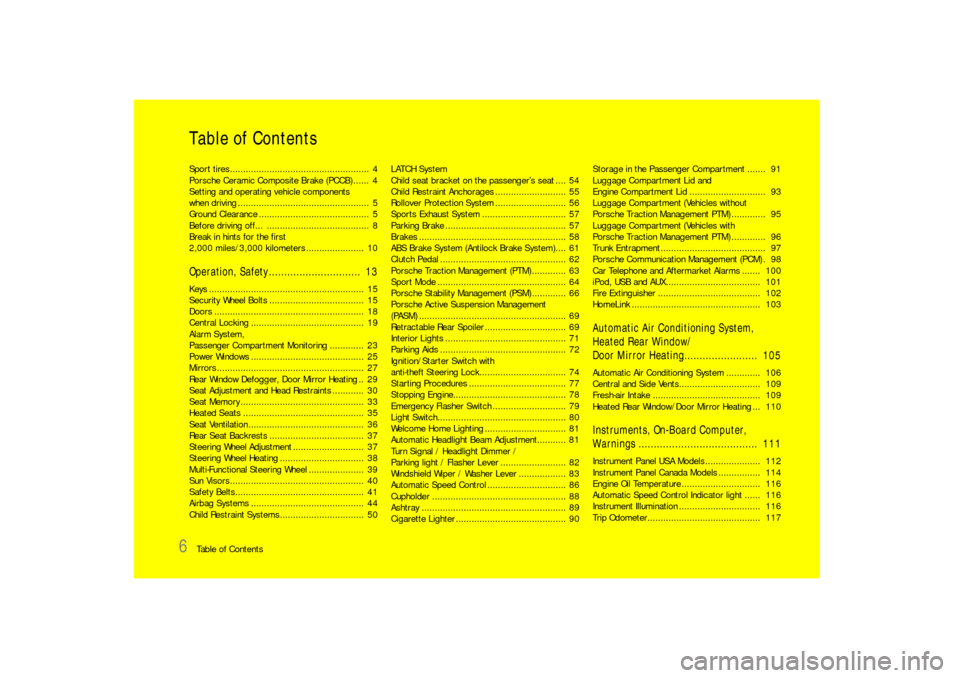
6
Table of ContentsTable of ContentsSport tires..................................................... 4
Porsche Ceramic Composite Brake (PCCB) ...... 4
Setting and operating vehicle components
when driving .................................................. 5
Ground Clearance .......................................... 5
Before driving off... ....................................... 8
Break in hints for the first
2,000 miles/3,000 kilometers ...................... 10Operation, Safety .............................. 13Keys ........................................................... 15
Security Wheel Bolts.................................... 15
Doors ......................................................... 18
Central Locking ........................................... 19
Alarm System,
Passenger Compartment Monitoring ............. 23
Power Windows ........................................... 25
Mirrors ........................................................ 27
Rear Window Defogger, Door Mirror Heating .. 29
Seat Adjustment and Head Restraints ............ 30
Seat Memory ............................................... 33
Heated Seats .............................................. 35
Seat Ventilation ............................................ 36
Rear Seat Backrests.................................... 37
Steering Wheel Adjustment ........................... 37
Steering Wheel Heating ................................ 38
Multi-Functional Steering Wheel ..................... 39
Sun Visors................................................... 40
Safety Belts................................................. 41
Airbag Systems ........................................... 44
Child Restraint Systems................................ 50LATCH System
Child seat bracket on the passenger’s seat .... 54
Child Restraint Anchorages ........................... 55
Rollover Protection System ........................... 56
Sports Exhaust System................................ 57
Parking Brake .............................................. 57
Brakes ........................................................ 58
ABS Brake System (Antilock Brake System).... 61
Clutch Pedal ................................................ 62
Porsche Traction Management (PTM) ............. 63
Sport Mode ................................................. 64
Porsche Stability Management (PSM) ............. 66
Porsche Active Suspension Management
(PASM) ........................................................ 69
Retractable Rear Spoiler ............................... 69
Interior Lights .............................................. 71
Parking Aids ................................................ 72
Ignition/Starter Switch with
anti-theft Steering Lock................................. 74
Starting Procedures ..................................... 77
Stopping Engine........................................... 78
Emergency Flasher Switch ............................ 79
Light Switch................................................. 80
Welcome Home Lighting............................... 81
Automatic Headlight Beam Adjustment........... 81
Turn Signal / Headlight Dimmer /
Parking light / Flasher Lever ......................... 82
Windshield Wiper / Washer Lever .................. 83
Automatic Speed Control .............................. 86
Cupholder ................................................... 88
Ashtray ....................................................... 89
Cigarette Lighter .......................................... 90Storage in the Passenger Compartment ....... 91
Luggage Compartment Lid and
Engine Compartment Lid ............................. 93
Luggage Compartment (Vehicles without
Porsche Traction Management PTM) ............. 95
Luggage Compartment (Vehicles with
Porsche Traction Management PTM) ............. 96
Trunk Entrapment ........................................ 97
Porsche Communication Management (PCM) . 98
Car Telephone and Aftermarket Alarms ....... 100
iPod, USB and AUX.................................... 101
Fire Extinguisher ....................................... 102
HomeLink ................................................. 103
Automatic Air Conditioning System,
Heated Rear Window/
Door Mirror Heating........................ 105Automatic Air Conditioning System ............. 106
Central and Side Vents............................... 109
Fresh-air Intake ......................................... 109
Heated Rear Window/Door Mirror Heating ... 110Instruments, On-Board Computer,
Warnings ....................................... 111Instrument Panel USA Models..................... 112
Instrument Panel Canada Models ................ 114
Engine Oil Temperature .............................. 116
Automatic Speed Control Indicator light ...... 116
Instrument Illumination............................... 116
Trip Odometer........................................... 117
Page 9 of 310
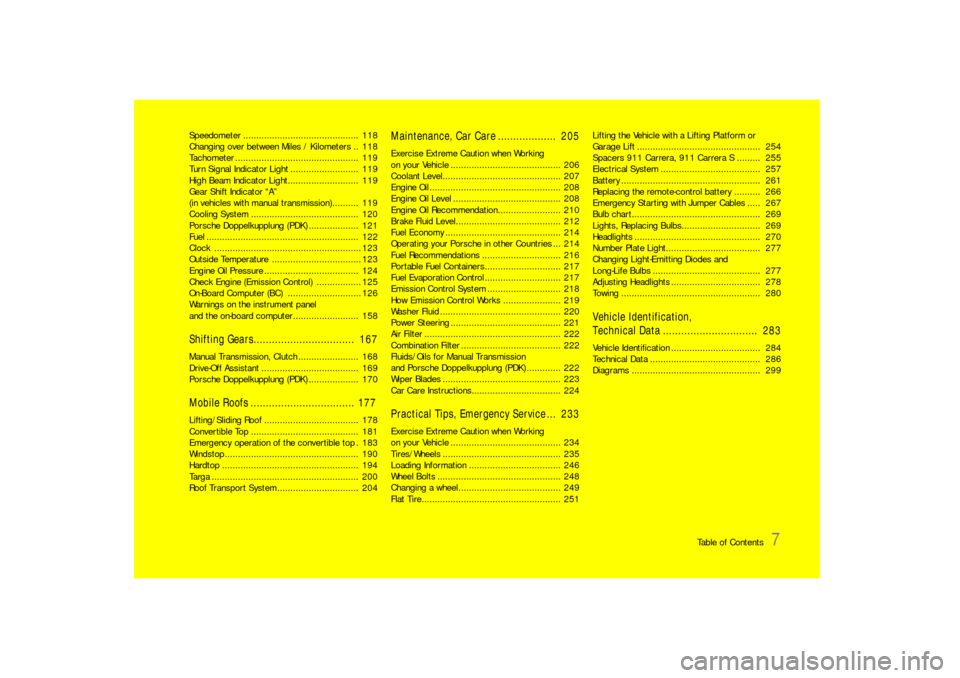
Table of Contents
7
Speedometer ............................................ 118
Changing over between Miles / Kilometers .. 118
Tachometer ............................................... 119
Turn Signal Indicator Light .......................... 119
High Beam Indicator Light........................... 119
Gear Shift Indicator “A”
(in vehicles with manual transmission).......... 119
Cooling System ......................................... 120
Porsche Doppelkupplung (PDK) ................... 121
Fuel .......................................................... 122
Clock ........................................................ 123
Outside Temperature .................................. 123
Engine Oil Pressure .................................... 124
Check Engine (Emission Control) ................. 125
On-Board Computer (BC) ............................ 126
Warnings on the instrument panel
and the on-board computer......................... 158Shifting Gears................................. 167Manual Transmission, Clutch ....................... 168
Drive-Off Assistant ..................................... 169
Porsche Doppelkupplung (PDK) ................... 170Mobile Roofs .................................. 177 Lifting/Sliding Roof .................................... 178
Convertible Top ......................................... 181
Emergency operation of the convertible top . 183
Windstop................................................... 190
Hardtop .................................................... 194
Targa ........................................................ 200
Roof Transport System............................... 204
Maintenance, Car Care ................... 205Exercise Extreme Caution when Working
on your Vehicle .......................................... 206
Coolant Level............................................. 207
Engine Oil .................................................. 208
Engine Oil Level ......................................... 208
Engine Oil Recommendation........................ 210
Brake Fluid Level........................................ 212
Fuel Economy ............................................ 214
Operating your Porsche in other Countries ... 214
Fuel Recommendations .............................. 216
Portable Fuel Containers............................. 217
Fuel Evaporation Control ............................. 217
Emission Control System ............................ 218
How Emission Control Works ...................... 219
Washer Fluid .............................................. 220
Power Steering .......................................... 221
Air Filter .................................................... 222
Combination Filter ...................................... 222
Fluids/Oils for Manual Transmission
and Porsche Doppelkupplung (PDK) ............. 222
Wiper Blades ............................................. 223
Car Care Instructions.................................. 224Practical Tips, Emergency Service ... 233Exercise Extreme Caution when Working
on your Vehicle .......................................... 234
Tires/Wheels ............................................. 235
Loading Information ................................... 246
Wheel Bolts ............................................... 248
Changing a wheel....................................... 249
Flat Tire..................................................... 251Lifting the Vehicle with a Lifting Platform or
Garage Lift ............................................... 254
Spacers 911 Carrera, 911 Carrera S ......... 255
Electrical System ...................................... 257
Battery ..................................................... 261
Replacing the remote-control battery .......... 266
Emergency Starting with Jumper Cables ..... 267
Bulb chart................................................. 269
Lights, Replacing Bulbs.............................. 269
Headlights ................................................ 270
Number Plate Light.................................... 277
Changing Light-Emitting Diodes and
Long-Life Bulbs ......................................... 277
Adjusting Headlights .................................. 278
Towing ..................................................... 280
Vehicle Identification,
Technical Data ............................... 283Vehicle Identification.................................. 284
Technical Data .......................................... 286
Diagrams ................................................. 299
Page 11 of 310

Before driving off...
9
In the driver’s seat... fCheck operation of the horn.
fPosition seat for easy reach of foot pedals and
controls.
To reduce the possibility of injury from the
airbag deployment, you should always sit back
as far from the steering wheel as is practical,
while still maintaining full vehicle control.
fAdjust the inside and outside rear view mirrors.
fBuckle your safety belts.
fCheck operation of the foot and parking brake.
fCheck all warning and indicator lights with
ignition on and engine not running.
fStart engine and check all warning displays for
warning symbols.
fNever leave an idling car unattended.
fLock doors from inside, especially with chil-
dren in the car to prevent inadvertent opening
of doors from inside or outside.
Drive with doors locked.
On the road... fNever drive after you have consumed alcohol
or drugs.
fAlways have your safety belt fastened.
fAlways drive defensively.
Expect the unexpected.
fUse signals to indicate turns and lane changes.
fTurn on headlights at dusk or when the driving
conditions warrant it.
fAlways keep a safe distance from the vehicle in
front of you, depending on traffic, road and
weather conditions.
fReduce speed at night and during inclement
weather.
Driving in wet weather requires caution and re-
duced speeds, particularly on roads with
standing water, as the handling characteristics
of the vehicle may be impaired due to hydro-
planing of the tires.
fAlways observe speed limits and obey road
signs and traffic laws.
fWhen tired, get well off the road, stop and take
a rest. Turn the engine off. Do not sit in the ve-
hicle with engine idling.
Please see the chapter “ENGINE EXHAUST” on
Page 5.fWhen parked, always set the parking brake.
Move the PDK selector lever to ”P“ or the gear-
shift lever to reverse or first gear.
On hills also turn the front wheels toward the
curb.
fWhen emergency repairs become necessary,
move the vehicle well off the road. Turn on the
emergency flasher and use other warning de-
vices to alert other motorists. Do not park or
operate the vehicle in areas where the hot ex-
haust system may come in contact with dry
grass, brush, fuel spill or other flammable ma-
terial.
fMake it a habit to have the engine oil checked
with every refueling.
Page 25 of 310
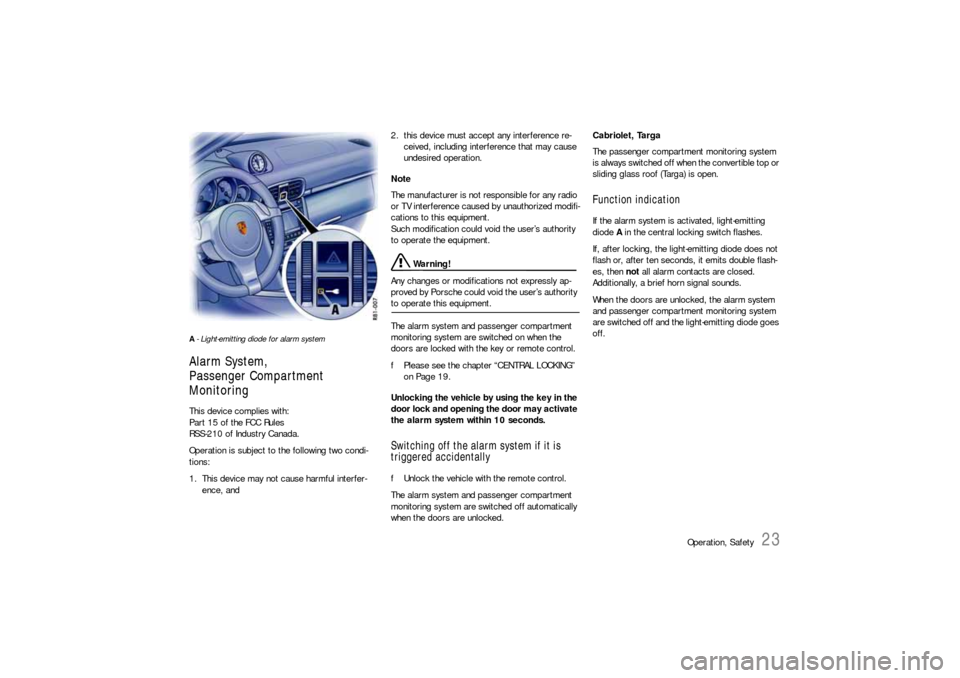
Operation, Safety
23
A- Light-emitting diode for alarm systemAlarm System,
Passenger Compartment
MonitoringThis device complies with:
Part 15 of the FCC Rules
RSS-210 of Industry Canada.
Operation is subject to the following two condi-
tions:
1. This device may not cause harmful interfer-
ence, and2. this device must accept any interference re-
ceived, including interference that may cause
undesired operation.
Note
The manufacturer is not responsible for any radio
or TV interference caused by unauthorized modifi-
cations to this equipment.
Such modification could void the user’s authority
to operate the equipment.
Warning!
Any changes or modifications not expressly ap-
proved by Porsche could void the user’s authority
to operate this equipment.
The alarm system and passenger compartment
monitoring system are switched on when the
doors are locked with the key or remote control.
fPlease see the chapter “CENTRAL LOCKING”
on Page 19.
Unlocking the vehicle by using the key in the
door lock and opening the door may activate
the alarm system within 10 seconds. Switching off the alarm system if it is
triggered accidentallyfUnlock the vehicle with the remote control.
The alarm system and passenger compartment
monitoring system are switched off automatically
when the doors are unlocked.Cabriolet, Targa
The passenger compartment monitoring system
is always switched off when the convertible top or
sliding glass roof (Targa) is open.
Function indication If the alarm system is activated, light-emitting
diode A in the central locking switch flashes.
If, after locking, the light-emitting diode does not
flash or, after ten seconds, it emits double flash-
es, then not all alarm contacts are closed.
Additionally, a brief horn signal sounds.
When the doors are unlocked, the alarm system
and passenger compartment monitoring system
are switched off and the light-emitting diode goes
off.
Page 28 of 310

26
Operation, Safety
Opening/closing windowsfFor the Cabriolet, select front or rear power
windows with rocker switch C.
The selection is displayed by the respective
light-emitting diode.
The two rocker switches A and B in the driver’s
door and the switch in the passenger’s door have
a two-stage function:
Opening
fPress the rocker switch down to the first stage
until the window has reached the desired
position.
Closing
fPress the rocker switch upwards to the first
stage until the window has reached the desired
position.
One-touch operation
fPress the rocker switch upwards or
downwards to the second stage.
Window moves to its final position.
Press again to stop the window in the desired
position.
Coupé, Targa
One-touch operation for closing the passenger’s
window is available once the window is approxi-
mately half-way closed.
Anti-crushing protectionIf a side window is blocked during closing, it will
stop and open again by about an inch.
Warning!
Risk of serious personal injuries.
If the rocker switch is pressed again within
10
seconds of the window being blocked, the
window will close with its full closing force.
Anti-crushing protection is disabled.
fOnce the anti-crushing protection acts to stop
the window and opens it slightly, do not press
the rocker switch again within 10 seconds
without checking to make sure that nothing is
blocking the path of the window.The window will close with full closing force.
One-touch operation is disabled for 10 seconds
after blockage of a side window.
Automatic window lowering fPlease see the chapter “DOORS” on Page 18.
fPlease see the chapter “CONVERTIBLE TOP”
on Page 181.Storing end position of the windowsIf the battery is disconnected and reconnected,
the windows will not be raised automatically when
the door is closed.
1. Close the windows with the rocker switch
once.
2. Press the rocker switch upwards again to store
the end position of the windows in the control
unit.
Page 30 of 310
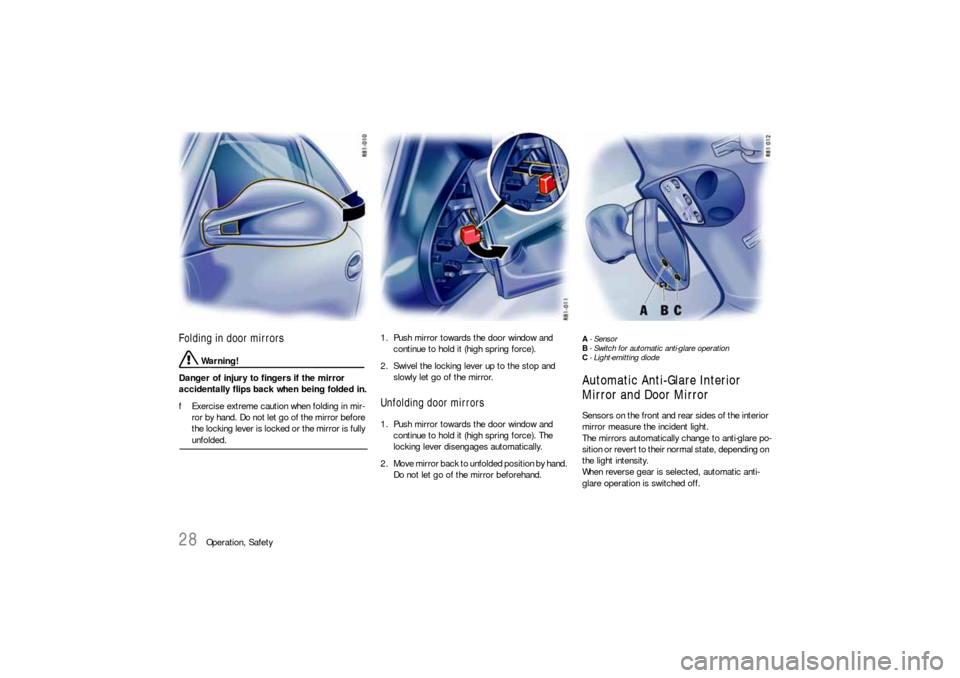
28
Operation, Safety
Folding in door mirrors
Warning!
Danger of injury to fingers if the mirror
accidentally flips back when being folded in.
fExercise extreme caution when folding in mir-
ror by hand. Do not let go of the mirror before
the locking lever is locked or the mirror is fully unfolded.1. Push mirror towards the door window and
continue to hold it (high spring force).
2. Swivel the locking lever up to the stop and
slowly let go of the mirror.
Unfolding door mirrors1. Push mirror towards the door window and
continue to hold it (high spring force). The
locking lever disengages automatically.
2. Move mirror back to unfolded position by hand.
Do not let go of the mirror beforehand.
A-Sensor
B- Switch for automatic anti-glare operation
C- Light-emitting diode Automatic Anti-Glare Interior
Mirror and Door Mirror Sensors on the front and rear sides of the interior
mirror measure the incident light.
The mirrors automatically change to anti-glare po-
sition or revert to their normal state, depending on
the light intensity.
When reverse gear is selected, automatic anti-
glare operation is switched off.
Page 31 of 310
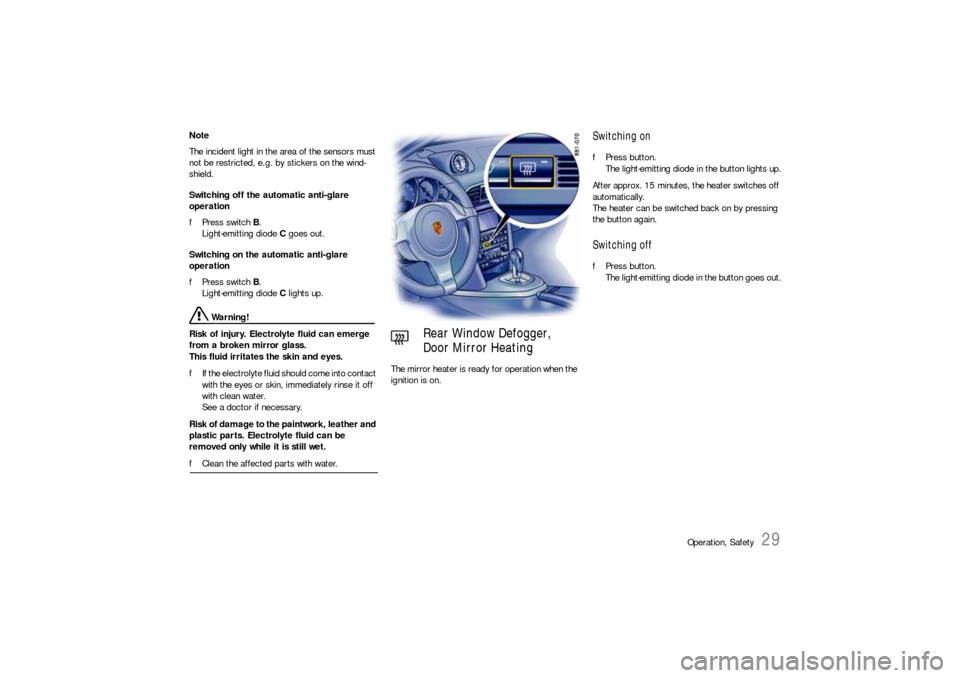
Operation, Safety
29
Note
The incident light in the area of the sensors must
not be restricted, e.g. by stickers on the wind-
shield.
Switching off the automatic anti-glare
operation
fPress switch B.
Light-emitting diode C goes out.
Switching on the automatic anti-glare
operation
fPress switch B.
Light-emitting diode C lights up.
Warning!
Risk of injury. Electrolyte fluid can emerge
from a broken mirror glass.
This fluid irritates the skin and eyes.
fIf the electrolyte fluid should come into contact
with the eyes or skin, immediately rinse it off
with clean water.
See a doctor if necessary.
Risk of damage to the paintwork, leather and
plastic parts. Electrolyte fluid can be
removed only while it is still wet.
fClean the affected parts with water. The mirror heater is ready for operation when the
ignition is on.
Switching on fPress button.
The light-emitting diode in the button lights up.
After approx. 15 minutes, the heater switches off
automatically.
The heater can be switched back on by pressing
the button again.Switching off fPress button.
The light-emitting diode in the button goes out.
Rear Window Defogger,
Door Mirror Heating
Page 32 of 310

30
Operation, Safety
Seat Adjustment and Head
Restraints
Warning!
The seat may move unexpectedly if you
attempt to adjust while driving. This could
cause sudden loss of control, resulting in se-
rious personal injury or death.
fDo not adjust seats while the vehicle is in mo-
tion.
The backrest locks must be engaged at all
times while the vehicle is in motion.
Safety belts only offer protection when the
backrest is upright and the belts are properly
positioned on the body.
Improperly positioned safety belts or safety
belts worn by passengers in an excessively
reclined position can cause serious personal
injury or death in an accident.
fDo not operate the car with the driver or
passenger backrests excessively reclined
(see “Seat position”).
Risk of injury if persons or animals are in the
movement range of the seat during seat
adjustment.
fAdjust the seat so that no-one is put at risk.
Caution!
Risk of damage to windshield, sun visor,
windstop, etc. when the seat is adjusted or
folded back or forward.
fAdjust the seat so that the s e a t b a c k re s t i s n o t in contact with any other object.
The driver and front passenger seats provide
integrated head restraints in the backrests. The
head restraints are not adjustable. The rear seats
do not provide head restraints. Warning!
All occupants, including the driver, should not
operate a vehicle or sit in a vehicle's seat until the
head restraints and backrests, respectively, are
placed in their proper positions so that the risk of
neck injuries is minimized in the event of a crash.
For proper positioning of the head restraint, the
seatback's inclination should be adjusted such
that the head restraint is in an upright position.
Driver and passengers should be seated upright
and in the center of their seats.
Seat positionAn ergonomically correct sitting position is
important for safe and fatigue-free driving.
We recommend the following procedure for adjust-
ing the driver’s seat to suit individual
requirements:
1.Vehicles with manual transmission:
Adjust the seat until, with the clutch pedal fully
depressed, your leg remains at a slight angle.
Vehicles with Porsche Doppelkupplung
(PDK):
Adjust the seat until, with your left foot on the
footrest, your left leg remains at a slight angle.
2. Rest your outstretched arm on the steering
wheel.
Set the backrest angle (not applicable for
Sports bucket seat) and the steering-wheel
position so that your wrist rests on the outer
rim of the steering wheel. At the same time,
the shoulders must still be in noticeable
contact with the backrest.
3. Adjust the seat height (not applicable for
Sports bucket seat) to give yourself enough
headroom and a good overview of the vehicle.
4. Electrically adjustable seat:
Adjust the seat angle until your thighs rest
lightly on the seat cushion.
Page 39 of 310
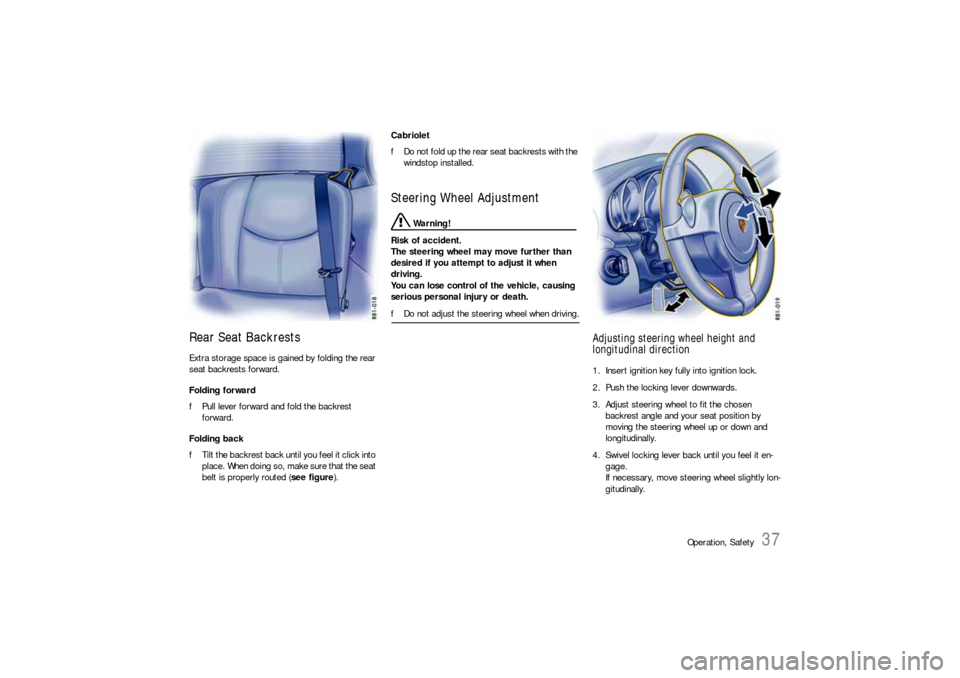
Operation, Safety
37
Rear Seat BackrestsExtra storage space is gained by folding the rear
seat backrests forward.
Folding forward
fPull lever forward and fold the backrest
forward.
Folding back
fTilt the backrest back until you feel it click into
place. When doing so, make sure that the seat
belt is properly routed (see figure).Cabriolet
fDo not fold up the rear seat backrests with the
windstop installed.
Steering Wheel Adjustment
Warning!
Risk of accident.
The steering wheel may move further than
desired if you attempt to adjust it when
driving.
You can lose control of the vehicle, causing
serious personal injury or death.
fDo not adjust the steering wheel when driving.
Adjusting steering wheel height and
longitudinal direction1. Insert ignition key fully into ignition lock.
2. Push the locking lever downwards.
3. Adjust steering wheel to fit the chosen
backrest angle and your seat position by
moving the steering wheel up or down and
longitudinally.
4. Swivel locking lever back until you feel it en-
gage.
If necessary, move steering wheel slightly lon-
gitudinally.